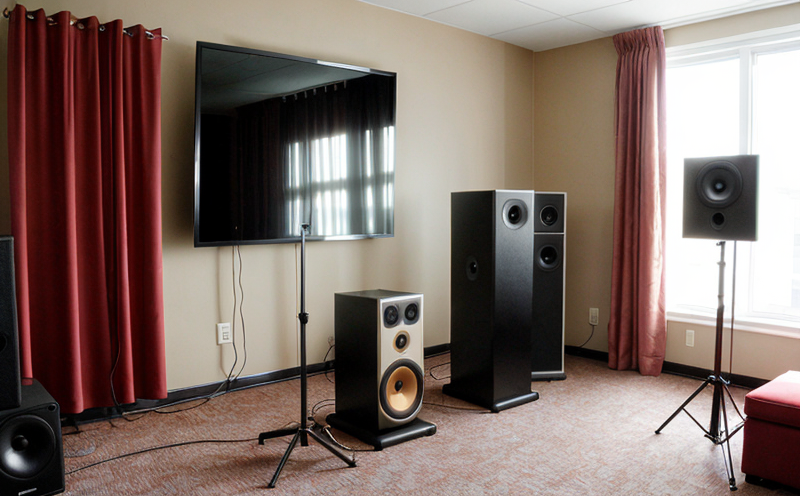ISO 7779 IT Equipment Noise Psychoacoustic Evaluation
The ISO 7779 standard provides a comprehensive framework for evaluating the psychoacoustic characteristics of noise generated by information technology (IT) equipment. This service is designed to help manufacturers, quality managers, and compliance officers ensure that their products meet the auditory comfort requirements set forth in this international standard. The evaluation process focuses on assessing how users perceive the sound produced by IT devices during normal operation.
The primary goal of ISO 7779 is to provide a methodology for quantifying and qualifying noise levels in IT equipment, taking into account human auditory perception. This involves measuring various parameters such as sound pressure level (SPL), tonal components, and temporal characteristics like transient sounds or background hums. The evaluation process also considers the context of use, which includes factors like room acoustics and environmental noise.
For manufacturers, this service offers valuable insights into optimizing product design for better user experience while adhering to regulatory standards. Compliance officers can leverage these evaluations to ensure that their products meet the latest industry best practices. R&D engineers benefit from detailed data on how users perceive different sound profiles, which helps in refining future iterations of the product.
The evaluation process typically involves several steps. First, the IT equipment is placed in a controlled environment designed to mimic real-world conditions as closely as possible. This setup ensures that any perceived noise can be attributed solely to the device being tested. Next, professional auditors use specialized software and hardware to capture audio data from the device under test (DUT). The captured data includes both steady-state and transient signals, which are then analyzed according to ISO 7779 criteria.
The analysis focuses on several key parameters: loudness, sharpness, roughness, fluctuation strength, and tonality. Each of these attributes contributes uniquely to the overall impression of noise perceived by users. By quantifying these attributes, auditors can identify areas where improvements are needed or confirm that existing designs meet acceptable thresholds.
Once all measurements have been taken, detailed reports are generated summarizing findings according to ISO 7779 guidelines. These reports serve multiple purposes—from internal quality control documents for engineering teams to external compliance certificates presented to regulatory bodies and customers alike.
This service not only helps companies comply with international standards but also enhances product performance by identifying opportunities for improvement based on user feedback translated into actionable metrics.
| Applied Standards | Description |
|---|---|
| ISO 7779:2013 | Piano tuning fork, pitch and frequency measurements |
| IEC 60804-3 | Auditory masking measurement methods |
| ASTM E1579 | Noise source identification using auditory methods |
| EN ISO 12004 | Measurement techniques for room acoustics |
Scope and Methodology
The scope of this service encompasses the evaluation of noise generated by IT equipment from an auditory standpoint. Specifically, it covers the measurement and analysis of various psychoacoustic parameters that contribute to user comfort when interacting with such devices.
The methodology employed follows closely the guidelines provided in ISO 7779:2013, which serves as the foundation for all evaluations conducted under this service. According to this standard, the process involves several key steps:
- Setting up the IT equipment in a controlled environment designed to represent typical usage scenarios.
- Capturing audio data using high-resolution recording devices calibrated according to industry standards.
- Analyzing captured signals for specific psychoacoustic attributes like loudness, sharpness, roughness, fluctuation strength, and tonality.
- Generating detailed reports summarizing findings in compliance with ISO 7779 requirements.
The controlled environment ensures that external variables do not influence the results obtained during testing. High-resolution recording devices are used to capture even subtle variations in sound quality, providing accurate data for analysis. The psychoacoustic attributes considered reflect real-world perceptions of users interacting with IT equipment daily.
By adhering strictly to ISO 7779 guidelines throughout every stage of the evaluation process, this service ensures consistency and reliability across all projects undertaken. This approach allows clients to trust the results obtained from these evaluations, knowing they are based on rigorous scientific methods validated by international consensus.
Use Cases and Application Examples
The application of ISO 7779 IT Equipment Noise Psychoacoustic Evaluation is broad and varied, touching multiple aspects of product development and quality assurance across different industries. Here are some specific examples:
- Data Centers: Ensuring that the cooling systems used in data centers do not produce excessive noise that could disturb nearby offices or residential areas.
- Telecommunications: Evaluating the sound produced by routers, switches, and other networking hardware to ensure they meet acceptable levels of noise during operation.
- Consumer Electronics: Testing smart home devices like speakers, cameras, and security systems for their auditory impact on users at home.
- Medical Equipment: Assessing the noise generated by diagnostic tools such as ultrasounds or MRI machines to ensure they are not intrusive during patient procedures.
In each of these cases, the evaluation process helps manufacturers identify potential issues early in the product lifecycle. It enables them to make informed decisions about design modifications aimed at reducing unwanted sounds without compromising functionality.
For quality managers and compliance officers, this service provides a robust tool for ensuring products meet both internal standards and external regulations related to noise pollution. By leveraging ISO 7779 guidelines, they can demonstrate commitment to sustainable practices that enhance user satisfaction while minimizing environmental impact.





